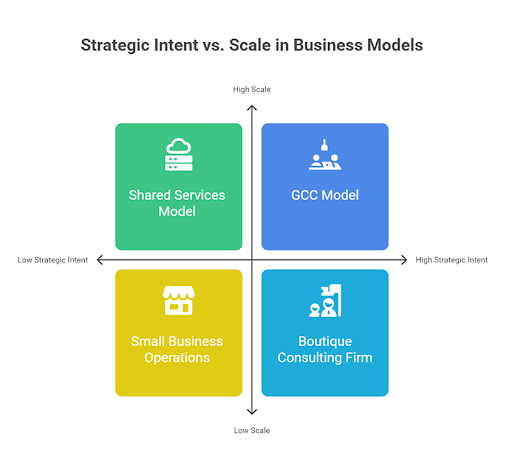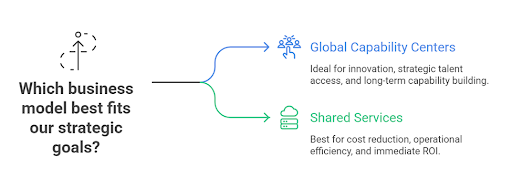GCC vs Shared Services: What’s the Difference?
- Home
- Blog Details

- August 21 2025
- Pankaj Singh
Consider the following scenario – A global manufacturing company faces a critical decision; establish a Global Capability Center (GCC) in India to accelerate their digital transformation journey, or opt for a Shared Services model and consolidate their back-office operations across North America and Europe. Both options promise substantial cost savings and increased operational efficiency, but which option will deliver sustainable competitive advantage?
- The traditional Shared Services Center (SSC) model, a proven way to consolidate routine business processes, is an effective tool to achieve cost reduction and operational accuracy. However, this model seems to become insufficient to meet the demands of a market witnessing rapid digital transformation.
- The strategic value of the Global Capability Center (GCC) model lies in its ability to generate competitive advantage, not just optimize costs. With a strong GCC partner, an enterprise can run the center as its own extension while focusing on high-value functions such as R&D, digital transformation, and product development, which are critical for future growth.
A GCC represents a dedicated, controlled, and talent pipeline needed to become a true strategic nerve center fostering innovation and supporting digital change. The ultimate objective with a GCC or a GCCaaS provider is not just cost savings, but a significant contribution toward the client’s competitive position.
The decision between GCC and Shared Services becomes a direct reflection of a company’s long-term vision.

Table of Contents
ToggleGCC vs. Shared Services: A Comparative Analysis for Business Leaders
The distinction between a GCC and a Shared Services approach is not one of scale but of strategic intent. Understanding these differences helps in making informed decisions about where and how to invest resources for long-term growth.
Shared Services Model – Consolidated Service Delivery
Cost Optimization and Enhanced Efficiency
The primary benefits of Shared Services revolve around operational efficiency and cost reduction:
- Economies of Scale: Achieve lower costs via elimination of redundant processes and consolidating resources throughout the global business
- Process Standardization: Establish uniform processes and best practices for all divisions, to reduce process variability and improve quality enterprise-wide.
- Optimize Resources: Streamline routine tasks using automation and technology, to free up in-house teams for undertaking strategic business initiatives.
- Enhanced Service Quality: Deploy standardized training and monitor performance to ensure that service delivery is consistent across departments.
GCC Or GCC as a Service – Strategic Growth and Value Creation
The main objectives of GCCs go beyond just cost reduction.
- Boost Innovation and R&D: Capability Centers are hubs for research, development, and technological innovation, with access to cutting-edge tools and highly skilled workforce.
- Leverage Global Talent: GCC partner helps a business tap into diverse, skilled talent pools in regions with robust educational systems and specialized expertise.
- Accelerate Digital Transformation: Businesses can benefit from expertise in AI, machine learning, and automation to optimize processes and drive innovation.
- Enhanced Operational Control: An organization maintains greater ownership of IP, data security, and business processes compared to third-party outsourcing models.
Innovation and R&D Focus
Today, GCCs are driven by capability rather than cost. They are key business units to develop and adopt cloud platforms and AI, strengthen cybersecurity, and fuel product innovation. For engineering-powered enterprises, GCC providers deliver benefits such as Knowledge-based Engineering solutions, development of complex software, and advanced manufacturing automation systems.
Decision Framework: Which Model Fits Your Business?

Primary Intent and Strategic Business Goals
Global Capability Centers (GCCs) are suited to enterprises seeking innovation, competitive market differentiation, with long-term capability building. They are ideal for high-value and complex processes, providing strategic access to specialized talent, and safeguarding intellectual property.
In contrast, the Shared Services model is opted when the primary objective is cost reduction, operational efficiency, and immediate ROI. It can be beneficial for standardized and repeatable processes, consistent service delivery, and centralized oversight for business compliance.
Resource Availability and Commitment
GCCs require substantial upfront investment – substantially lower investment if partnering with a GCCaaS provider like Prescient Technologies – executive-level sponsorship, and a long-term commitment to innovation and capability development. However, they ensure business resilience and the ability to manage complex, distributed operations.
Shared Services, on the other hand, need moderate initial investment, since they only focus on operational excellence, with clear opportunities for process standardization and defined service levels.
Risk Mitigation and Longer Timeline
A GCC strategy could be risky but promises greater long-term rewards, by tackling challenges in setup, talent acquisition, offshore compliance, and uncertain ROI on innovation strategies.
Shared Services present a lower-risk profile, with proven deployment methods and delivering predictable ROI. But they can face difficulties related to process harmonization, resistance to change, and sustaining consistent service delivery.
Decision Implications
Selecting a GCC or Shared Services model will depend on organizational maturity, long-term ambition, and risk appetite. Enterprises who prioritize innovation, market differentiation, and resilient capability building must lean toward the GCC or GCCaaS models. If a company is focused only on efficiency, standardization, and predictable cost savings, it can opt for Shared Services. A clear understanding of business will help determine the most sustainable and impactful model.
As organizations navigate digital transformation and global competitiveness, the importance of making informed decisions based on business priorities, resources, and tolerance for complexity becomes critical. Whether an enterprise chooses to establish a GCC partnership, implement shared services, or pursue a hybrid approach, success will depend on aligning choices with broader strategy and keeping focus on long-term value creation.
Pankaj Singh has extensive experience in market research and content creation within the industrial sector. He currently writes insightful articles related to business, manufacturing, technology, and automation for Prescient Technologies.
- Pankaj Singhhttps://www.pre-scient.com/author/srvprescient/
- Pankaj Singhhttps://www.pre-scient.com/author/srvprescient/
- Pankaj Singhhttps://www.pre-scient.com/author/srvprescient/
- Pankaj Singhhttps://www.pre-scient.com/author/srvprescient/


